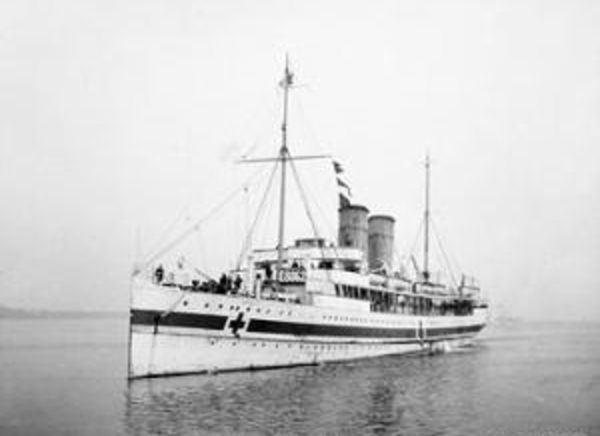HMHS Anglia on:
[Wikipedia]
[Google]
[Amazon]
SS ''Anglia'' was a steam ship requisitioned for use as a


hospital ship
A hospital ship is a ship designated for primary function as a floating medical treatment facility or hospital. Most are operated by the military forces (mostly navies) of various countries, as they are intended to be used in or near war zones. ...
during the First World War
World War I (28 July 1914 11 November 1918), often abbreviated as WWI, was one of the deadliest global conflicts in history. Belligerents included much of Europe, the Russian Empire, the United States, and the Ottoman Empire, with fightin ...
. On 17 November 1915 she hit a mine
Mine, mines, miners or mining may refer to:
Extraction or digging
* Miner, a person engaged in mining or digging
*Mining, extraction of mineral resources from the ground through a mine
Grammar
*Mine, a first-person English possessive pronoun
...
laid by the German U-boat
U-boats were naval submarines operated by Germany, particularly in the First and Second World Wars. Although at times they were efficient fleet weapons against enemy naval warships, they were most effectively used in an economic warfare role ...
, ''UC-5''.
History
''Anglia'' was built by Wm Denny & Brothers ofDumbarton
Dumbarton (; also sco, Dumbairton; ) is a town in West Dunbartonshire, Scotland, on the north bank of the River Clyde where the River Leven flows into the Clyde estuary. In 2006, it had an estimated population of 19,990.
Dumbarton was the ca ...
, Scotland for the London and North Western Railway
The London and North Western Railway (LNWR, L&NWR) was a British railway company between 1846 and 1922. In the late 19th century, the L&NWR was the largest joint stock company in the United Kingdom.
In 1923, it became a constituent of the Lo ...
and was delivered in 1900. At first she was used on the Holyhead
Holyhead (,; cy, Caergybi , "Cybi's fort") is the largest town and a community in the county of Isle of Anglesey, Wales, with a population of 13,659 at the 2011 census. Holyhead is on Holy Island, bounded by the Irish Sea to the north, and is ...
to Dublin North Wall service, then from 1908 on the Holyhead to Kingstown (later named Dún Laoghaire
Dún Laoghaire ( , ) is a suburban coastal town in Dublin in Ireland. It is the administrative centre of Dún Laoghaire–Rathdown.
The town was built following the 1816 legislation that allowed the building of a major port to serve Dubli ...
) service. With the outbreak of war she was drafted as a hospital ship.

Sinking
On 17 November 1915 ''Anglia'' was returning fromCalais
Calais ( , , traditionally , ) is a port city in the Pas-de-Calais department, of which it is a subprefecture. Although Calais is by far the largest city in Pas-de-Calais, the department's prefecture is its third-largest city of Arras. Th ...
to Dover
Dover () is a town and major ferry port in Kent, South East England. It faces France across the Strait of Dover, the narrowest part of the English Channel at from Cap Gris Nez in France. It lies south-east of Canterbury and east of Maidstone ...
, carrying 390 injured officers and soldiers. At around 12:30 pm, east of Folkestone Gate, HMHS ''Anglia'' struck a mine and sank in fifteen minutes. The nearby torpedo gunboat
In late 19th-century naval terminology, torpedo gunboats were a form of gunboat armed with torpedoes and designed for hunting and destroying smaller torpedo boats. By the end of the 1890s torpedo gunboats were superseded by their more successful c ...
HMS ''Hazard'' helped evacuate the passengers and crew. Despite the assistance of the nearby collier ''Lusitania'', 134 people died in the sinking. In October 2014, there were calls for the wreck of the ship to be designated a war grave and protected under the Protection of Military Remains Act, 1986.
In March 2017 the wreckage of the HMHS Anglia was declared an official war grave, making it illegal to remove or disturb any human remains at the wreck site.

See also
*List of hospital ships sunk in World War I
During the First World War, many hospital ships were attacked, sometimes deliberately and sometimes as a result of mistaken identity.
They were sunk by either torpedo, mine or surface attack. They were easy targets, since they carried hundreds of ...
References
External links
{{DEFAULTSORT:Anglia Maritime incidents in 1915 Hospital ships in World War I 1899 ships Ships built on the River Clyde Ships sunk by mines Ships of the London and North Western Railway World War I shipwrecks in the English Channel Protected Wrecks of the United Kingdom